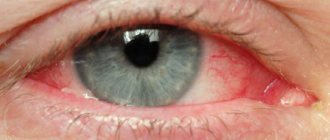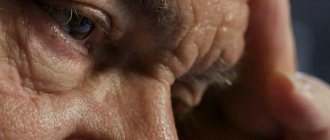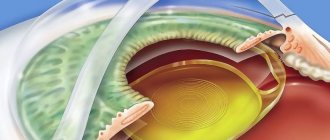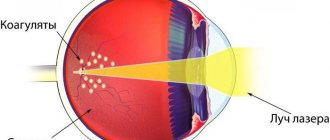The development of cataracts in patients with glaucoma complicates the course of the underlying disease. Cataracts are also one of the many causes of glaucoma in the eye. The co-occurrence of glaucoma and cataracts is one of the most common causes of blindness worldwide.
- What is cataract
- What is glaucoma
- Glaucoma plus cataract. In what cases does one disease become a complication of another?
- The first signs of simultaneous manifestations of glaucoma and cataracts
- Contraindications for glaucoma and cataracts
- Is it possible to have cataract surgery for glaucoma?
- Glaucoma and cataract: simultaneous treatment and surgery
- Combined surgery: lens replacement and anti-glaucoma surgery
- Postoperative and rehabilitation periods
What is glaucoma?
Glaucoma is a group of chronic eye diseases with different etiologies, characterized by a constant or periodic increase in intraocular pressure, under the influence of which the nerve fibers of the retina and optic nerve die, as a result of which typical defects in the visual field are formed, and visual functions are reduced until complete loss of vision.
What physical exercises are allowed during treatment for glaucoma: is it possible to work in the garden?
When treating glaucoma, you need to work in the garden with caution
It was already mentioned above that light physical labor and exercise without excessive stress are not only not prohibited, but, on the contrary, are encouraged. Calm walking, leisurely cycling, and morning exercises will only bring benefits.
All this imposes certain restrictions on professional and domestic work. Is it possible to work in the garden?
- Of course you can. But at the same time, it is forbidden to carry heavy objects and bend over - lift no more than 3 kg.
- Prolonged exposure to the sun is also undesirable. Try to work in the shade of trees, sitting on a low chair.
Take care of yourself, don't overwork. Each person is able to create for himself the conditions under which the health of his eyes will not be endangered.
Glaucoma plus cataract. In what cases does one disease become a complication of another?
Glaucoma and cataracts occur together so often that doctors talk about cause-and-effect relationships in their development. Most often, glaucoma is complicated by cataracts. Most often, the complication occurs in elderly patients. At a certain stage in the development of glaucoma, one should always expect the addition of cataracts. This occurs due to disturbances in microcirculation inside the eye, which leads to the development of cataracts.
In turn, cataracts in some cases can cause glaucoma. This form of glaucoma is called phacomorphic and develops due to swelling (increase in volume) of the cloudy lens, which in turn causes narrowing and closure of the outflow pathways of intraocular fluid.
Definition of eye drops
Eye drops used for glaucoma are medications that help stop the progression of the disease.
Drops are prescribed by an ophthalmologist. Indications for use are based on the therapeutic properties of the drug.
Drops are considered a necessary component for the conservative treatment of glaucoma. Their action is aimed at reducing and normalizing eye pressure, which leads to the formation of the optic nerve and blindness.
Drops are prescribed to prevent nerve atrophy and maintain normal vision. If the nerves atrophy, the field of vision narrows, it becomes tunnel-like. Progression leads to complete loss of vision.
Drops are very effective in the initial stages of glaucoma, but their use must be prescribed by a doctor.
The first signs of simultaneous manifestations of glaucoma and cataracts
The primary symptoms of glaucoma and cataracts differ, but when the two diseases combine in the eye, they combine and intensify.
Signs of glaucoma:
- fog before the eye occurs periodically, mainly at night;
- in the initial stages of the disease, visual acuity does not decrease, a gradual narrowing of the visual fields occurs, which a person with glaucoma does not notice;
- rainbow circles around light sources appear periodically;
- there may be pressing, aching pain, a feeling of heaviness in the eyes;
- possible redness of the eye.
Signs of cataracts:
- the appearance of persistent fog in front of the eye, while in sunny weather the fog may intensify;
- vision decreases gradually due to increasing fog;
- the appearance of a persistent halo effect (halo) when looking at a light source;
- there is no pain syndrome;
- the eye does not turn red.
Effective drops for cataracts
For a diagnosed disease such as cataracts, the following effective drops are prescribed:
- Common drops for cataracts are Oftan Katahrom, which contains a powerful antioxidant. It is this substance in the drops that has a beneficial effect on the sensitive tissues of the cornea, where the active formation of free radicals occurs, causing severe clouding of the lens.
- For congenital, senile, secondary or traumatic cataracts and the prevention of glaucoma, Vita-iodurol drops are used. They are distinguished by their rich composition of antioxidants and important amino acids, which help improve blood supply to the eye.
- Taufon is prescribed to effectively restore and normalize the functions of cell membranes. The product has proven its effectiveness in the treatment of cataracts and glaucoma.
- To enhance fat, energy and carbohydrate metabolism in the tissues of the eye, take Quinax. They are able to quickly destroy opaque proteins accumulated in the body of the lens, returning it to its former ability to transmit light rays.
- Smirnov's pharmaceutical drops are made on the basis of patients' personal recipes; they are effective for senile cataracts, and are also effective for glaucoma. They help replenish the eye’s previous nutrition and correct internal metabolic processes.
These are the most basic remedies that are most often used in the treatment of inoperable cataracts.
Is it possible to have cataract surgery for glaucoma?
Cataracts can only be treated surgically. Drug treatment cannot make a clouded lens clear! During the operation, the ophthalmic surgeon removes the clouded lens and implants an artificial intraocular lens in its place.
It is not only possible, but necessary, to perform cataract surgery in the presence of glaucoma. At the same time, earlier surgical intervention makes it possible to more effectively and safely achieve the desired result.
However, eliminating cataracts in glaucoma requires a special approach and careful preparation for surgery.
Treatment of diseases
The resin should be fir or pine, but not spruce. The product is collected from a tree trunk. To do this, they pass by hand and determine by touch the cortical areas, which are particularly elastic and resilient. Here you need to make cuts and collect the protruding liquid in a pre-prepared container. This juice is the resin.
The resulting liquid is mixed with vegetable oil. The most effective use of sea buckthorn oil. but peeled sunflower oil will also work. To prepare the composition, take 3 parts vegetable oil and 1 part resin, stir thoroughly. Used as eye drops. Dosage – 1 drop in each eye once a day. The course of treatment is 30-40 days.
To treat cataracts by using resin, you should remember that it is used only in fresh form. Long-term storage leads to loss of beneficial properties of juice. In addition, the resulting composition causes a burning sensation that must be endured.
Bile is an equally popular folk remedy in the treatment of cataracts. The use of bile for this disease is described in the chronicles of healers.
The well-known healer Porfiry Ivanov gives his recipe using bile. He claims that instilling 1 drop of bile into each eye daily completely eliminates cataracts.
One condition is that bile is taken only from live pike. The drug is instilled before bedtime.
The course consists of 10 procedures with an interval of one day, a break of 10 days and repetition. If it was not possible to immediately repeat the course, then treatment should be resumed no earlier than after 2 months.
Bile causes discomfort, expressed by pain and burning, but this period must be endured.
Glaucoma is one of the most serious eye diseases in our time. This is due to the fact that a person not only loses vision, but also suffers from increased intraocular pressure.
Despite the severe symptoms of the disease, glaucoma can be treated not only with surgery, but also with medications.
- slight pain around the eyes;
- poor ability to see in the dark;
- feeling of excessive moisture in the eye;
- cutting sensations;
- the appearance of a foggy effect when concentrating.
- Open angle;
- Closed angle;
- Mixed.
- pilocarpine solutions 1-2%;
- solutions of isoptocarbachol 1.5-3%;
- solutions of pilocaprine hydrochloride with methylcellulose 1%.
- solutions of timoptic 0.25% and 0.5%;
- timoptika-depot;
- solution of oftan-timolol 0.25% and 0.5%;
- betaxolol hydrochloride solution;
- suspension Betoptic –S 0.25%;
- xalatan solution 0.005%;
- Travatan solution 0.004%.
- trusopt solution 2%;
- Azopt solution 2%.
- iridectomy;
- trabeculoplasty.
At the initial stage of the disease, specialists use medications. which help normalize intraocular pressure and maintain normal blood supply to the inner lining of the eye.
Treatment of angle-closure glaucoma
To treat angle-closure glaucoma, drops are used that can narrow the pupil of the eye and cause spasm of the ciliary muscle. This helps open the angle of the anterior chamber, improves the uniform outflow of moisture, but causes some visual impairment.
These medications provide short-term relief, since in angle-closure glaucoma, optic nerve atrophy occurs much faster.
Patients with this form of the disease require surgical treatment in 90% of cases. Surgery is prescribed if drug therapy does not bring relief and does not stop the increase in intraocular pressure.
Treatment of open-angle glaucoma
The above solutions are contraindicated for people suffering from heart failure, bronchial asthma, and cardiac dysfunction.
All drugs in this series exclude the possibility of increasing pupil volume, as well as accommodation.
Drugs with combined effects are prescribed to patients with glaucoma with mixed forms of manifestation.
In the early stages of the disease, ophthalmologists recommend laser treatment for glaucoma. The operation is performed under local anesthesia and does not require hospitalization. However, in later and advanced cases, doctors have to resort to surgery.
Trabeculectomy
This surgical operation allows the formation of new channels for the drainage of aqueous humor from the anterior chamber of the eye under the conjunctiva. This creates alternative pathways for fluid to escape, resulting in reduced pressure on the eyeball.
This technique is used most often and is used to treat almost all forms of glaucoma, but like any operation it can cause a number of complications. Post-operative scars may become chronic, and glaucoma and vision loss may return to their previous stages.
Sclerectomy
The advantage of this fairly common operation is that the natural mechanisms for the outflow of excess fluid are not disrupted. The fluid pressure inside the eye decreases to the required level.
Treatment of glaucoma is an extremely complex and painstaking process.
The general course of treatment involves maintaining normal intraocular pressure. This condition is maintained with the help of diuretics, vascular drugs, and special eye drops. The course of drug treatment must be discussed with your doctor in advance.
Please note that the advanced stage of the disease will certainly lead to blindness. The sooner a person seeks proper help, the more successful the entire course of treatment will be. The condition of glaucoma depends entirely on your lifestyle and your compliance with your doctor's recommendations.
First of all, patients with glaucoma need to avoid nervous disorders, stress and excessive physical activity.
It will not be superfluous to follow a balanced diet. which will include plant components. Eating fried and fatty foods should be avoided.
To date, there are no reliable ways and methods that could accurately prevent the development of this disease. But as soon as you suspect the first symptoms of glaucoma, you need to urgently, without delaying for a second, contact a specialist.
Eye drops do not help get rid of cataracts!
Drops can only stop its development. Treatment of cataracts is only surgical!
The only effective treatment for cataracts is surgical removal of the cataract and implantation of an artificial intraocular lens instead.
In this case, it is no longer possible to restore sight to a blind patient!
Non-surgical treatment involves intervention in the structure of the eye without cutting. On the one hand, this method gives fewer side effects and negative consequences, and is characterized by rapid recovery after the procedure.
The patient does not need to stay in the hospital; he can go home a few hours after the procedure. On the other hand, the solution to the problem is temporary, the normalization of IOP is short-term, and repeated intervention is required.
It is used when surgical treatment of glaucoma is contraindicated.
Laser correction
If treatment for glaucoma does not improve vision, surgery is prescribed.
During an iridectomy, one or more holes are made in the iris to allow intraocular fluid to move between the chambers. Trabeculoplasty involves using a laser to target the trabecular diaphragm to improve fluid outflow. These manipulations are carried out under the influence of local anesthetic using a special lens. The procedure lasts about half an hour.
The advantages of laser treatment for glaucoma are the use of a local anesthetic rather than general anesthesia and minimal impact on the eye, which reduces the risk of complications. The disadvantage of this method is the short-term effect.
This procedure helps for a period of 1 to 5 years; with secondary correction, this period is reduced. Possible adhesion of tissue at the sites of laser action or damage to the retina, iris or blood vessels.
Cryodestruction
Surgery is used if glaucoma medications and non-invasive methods do not work. To prepare for such operations, IOP is reduced by medication to a minimum value and antihistamines are taken. If possible, eliminate inflammatory processes in the eyes or prescribe antibiotics.
Glaucoma surgery includes 5 groups of operations, from which the doctor chooses the most appropriate one.
The essence of antiglaucomatous operations is to artificially create additional pathways for the outflow of intraocular fluid. After surgery, aqueous humor flows freely from the eye, thereby reducing the pressure inside it. Consequently, the optic nerve stops being injured, and vision stabilizes.
It is almost impossible to fully cure glaucoma without the use of surgical methods. But there are also exceptions.
For example, the initial stage or the second. In this case, an integrated approach is necessary.
The patient must take the prescribed medications and apply special drops to the eyes. In addition, be sure to do special eye exercises for glaucoma, breathe fresh air and eat right.
Glaucoma and cataract: simultaneous treatment and surgery
Glaucoma and cataracts require different treatment approaches. Patients with glaucoma reduce intraocular pressure using drops or laser/surgical interventions. It is impossible to get rid of cataracts with medications.
Before proceeding with cataract surgery, it is necessary to achieve compensation (reduction) of intraocular pressure.
To treat glaucoma, one or more antihypertensive medications may be prescribed and used until the day of surgery.
In some cases, surgery for cataracts in a glaucomatous eye can cause a temporary increase in intraocular pressure in the postoperative period, so the hypotensive regimen may intensify.
How is lens replacement surgery performed for glaucoma?
Hello, dear readers! Today, I want to talk about serious methods of treating such an ophthalmological disease as glaucoma. This pathology develops gradually and quietly, slowly “eating” vision.
Thus, patients are very often in no hurry to take drastic measures and go to the operating table, but prefer to trust conservative medicine. But medications, exercises and traditional methods do not always help, and over time, vision deteriorates and complete blindness can occur.
It should be understood that medications will only slow down the process and eliminate some symptoms, but not the disease itself. This chronic, progressive disease will sooner or later require surgical intervention. In modern ophthalmology, there are many effective surgical procedures, and one of the most popular among them is lens replacement for glaucoma.
Let me introduce you to this method of surgical intervention, when it is allowed to be done and the features of the procedure in general.
Lens replacement during illness: why and when should you think about surgery?
If earlier, patients with glaucoma expected inevitable blindness due to the lack of necessary treatment, then at the present time, all conditions have been created to eliminate it. All therapeutic measures are divided into three categories, each of which has its own characteristics and is prescribed only by the attending physician.
Their choice depends on the characteristics of the course of the disease, the stage of its development and the age of the patient. All methods for eliminating glaucoma are united by the need to normalize intraocular pressure. These include conservative treatment, laser correction and surgery.
If the disease is diagnosed at an early stage of its development, the patient may be prescribed medications to lower IOP. This method of therapy will only help slow down the course of the disease, but will not cure it.
In addition, it is quite difficult to choose truly effective drugs for a particular case. The danger of such measures is that the pressure often rises at night, when the patient is sleeping and does not suspect anything. You will have to use medications strictly on an hourly basis and throughout your life.
Drug treatment is not always effective, so surgical methods have been developed for glaucoma of various degrees. They are simply necessary if you need to normalize the circulation of intraocular fluid so that it does not accumulate and increase the pressure in the eyes. The effectiveness of such procedures is almost 100%.
Surgeries to replace the lens in case of eye damage from glaucoma allow you to clearly see the world around you in just a couple of days, and in less than a week, enjoy the complete healing and restoration of your visual organs.
Lens implantation for glaucoma: stages of the procedure
Lens replacement surgery involves removing the original deformed lens and placing an intraocular lens in its place. Local anesthesia is used during the process. The operation consists of the following steps:
- examination of the patient by the attending physician before a surgical procedure to identify existing heart or vascular diseases. When diagnosing such deviations, surgery is prohibited;
- in case of a favorable preoperative medical examination, a lens is selected that is ideal for the eye and can correct vision by replacing glasses and contact lenses;
- first, the doctor makes an incision in the eye with a diameter of 1.3-1.6 mm, through which the lens will be removed, leaving free space for the implant;
- the doctor places the artificial organ in place of the removed one, and the film of the eye sac prevents its rejection.
Important! This operation lasts only 15 minutes, after which the patient is left in the clinic for a couple of days or sent home, depending on his well-being. A similar procedure for replacing the lens is performed for both glaucoma and cataracts.
Intraocular lenses: which ones are selected for glaucoma?
An IOL is inserted into the place of the removed native organ, which is placed inside in the form of a rolled-up roll and flattens itself. After this process, there is no need to apply stitches, since the implant will soon close under the influence of pressure in the organs of vision.
Intraocular lenses for glaucoma are selected by an ophthalmologist in accordance with the parameters of the patient’s visual apparatus. There are artificial organs to correct myopia and farsightedness, for excellent twilight vision or protection from ultraviolet rays.
Only a doctor can determine which lenses are best for a particular case, but often they use products from manufacturers such as:
- Bausch+Lomb, USA;
- Zeiss, Germany;
- Alcon, USA;
- Rayner, England;
- Lenzaflex, Russia.
The cost of an IOL averages $100-200 per lens. The American manufacturer offers products from 19 thousand rubles, and the Zeiss company - from 50 thousand rubles. The price of lenses from Lenzaflex is quite low and ranges from 400-500 rubles. for a rigid IOL and 600-700 rubles. - for the soft one.
Postoperative period: rules for eye restoration after lens replacement
You will learn what results to expect after replacing the lens and how to care for your eyes at home afterward from the reviews that I have selected:
Christina, 39 years old: “Last year I had an operation to replace my lens. My diagnosis is “cataracts and glaucoma.” I was very worried whether the procedure would help or whether it would only get worse. Fortunately, the operation was quick and painless, and my vision was excellent by the third day.
The most difficult thing for me was to adhere to all the doctor’s recommendations in the postoperative period. It was forbidden to engage in strenuous sports, touch the operated eye with your hands, use cosmetics, stay in the sun for a long time and swim in ponds. It was especially difficult to adhere to these rules, since the beach season had arrived and all my friends went to the sea. But I managed to survive and now I can see perfectly.”
Timur, 42 years old: “I had stage 3 glaucoma, and the doctor said that I needed surgery to replace the lens. I agreed, stood in line and finally realized my dream - I regained 100% of my vision and began to see the world in bright colors.
As for the recovery period, it is important to follow all the doctor’s recommendations. I used healing, restorative medications, followed a special diet and did not overstrain my eyes. The result exceeded my expectations."
As you can see, it is not enough to simply replace the lens and not monitor the eyes yourself, since the operation is only half the success, and further progress depends on the patient himself. Reviews from those who have experienced this method themselves confirm this as well as possible.
Video about which method can help you avoid surgery
The video talks about how sclerectomy can help restore visual vision in case of illness. The doctor says that this is an effective method of surgical intervention today. True, the method stops the progression of the disease, but replacing the lens completely renews the eyes and the person begins to see well.
I believe that if the disease is detected at an early stage, then it is possible to avoid having to carry out a second surgical procedure to change the implant. The best thing is timely completion of diagnostic measures and, of course, effective treatment of the disease in the early stages.
conclusions
Take care of your health, take care of your eyes, take preventive measures to avoid ophthalmic diseases. And also, do not despair if you are diagnosed with one of the eye pathologies, since modern medicine offers a number of measures to eliminate them.
If, however, you managed to encounter a problem and even solved it with the help of medication or surgical methods, then be sure to share it in the comments under this article! Every experience is important to us! Take care of yourself and your eye health! Best regards, Olga Morozova!
ARTICLES ON THE TOPIC: Dystrophic secondary glaucoma
Check glaucoma What is hidden glaucoma Vision restoration blindness glaucoma Open-angle primary glaucoma
Combined surgery: lens replacement and anti-glaucoma surgery
If it is impossible to reduce intraocular pressure to acceptable levels before surgery for cataracts using antihypertensive drops, a decision is made in favor of a combined intervention. It is also possible to carry out 2 operations at different times.
The decision on the tactics of surgical intervention for glaucoma and cataracts is made strictly individually, after conducting a full ophthalmological examination and assessing all possible operational and postoperative risks, as well as taking into account the severity of somatic pathology.
Drops that promote the outflow of intraocular fluid
This group of drugs includes cholinomimetics, prostaglandins and sympathomimetics. Let's look at each type in more detail.
Cholinomimetics
This group of medications for glaucoma is used to effectively lower ophthalmotonus (i.e., intraocular pressure or IOP). As mentioned above, they also normalize the outflow of fluid inside the eye, which occurs due to the narrowing of the pupil.
Pilocarpine
Main active ingredient: pilocarpine.
How to use for primary glaucoma: instill 1 drop up to 6 times a day.
Rules for use in acute attacks of angle-closure glaucoma:
- 1 drop with a 15-minute break for 2 hours;
- on the 3rd and 4th hour every half hour;
- during the rest of the attack - 1 time per hour.
Isoptocarbachol
Main active ingredient: carbacholine.
Method of application: installed 2-4 times throughout the day for closed-angle glaucoma.
Aceclidine
Main active ingredient: aceclidine.
Directions for use: drip 1-2 drops at least 5 times during the day.
Main contraindications: allergies to the constituent components, inflammatory processes of the ciliary body membrane, iris of the eyes.
Side effects: slight redness, burning, short-term attacks of myopia, headache, lacrimation.
Prostaglandins
The medicinal effectiveness of prostaglandins lies in their effect on certain receptors that are located in the ciliary muscles. After their use, the drainage system of the eyes works better and the outflow of fluid inside them is normalized. This effect lasts all day, which distinguishes prostaglandin drugs from others.
Xalatan, Glauprost, Xalatamax, Latanoprost
Main active ingredient: latanoprost.
Directions for use: 1 drop once a day, preferably at the same hour.
Main active ingredient: travoprost.
Directions for use: 1 drop once a day.
Taflotan
Main active ingredient: tafluprost.
Directions for use: instilled in the evening, 1 time in each eye.
Contraindications to the use of prostaglandins:
- The age of the patient, since these drugs are allowed to be prescribed only to adults. This does not apply to combination medications containing latanoprost (we'll talk about them below).
- Pregnancy and lactation period.
- Bronchial asthma, diseases of the lens and iris.
Side effects:
- redness;
- itching
- opacities in the cornea.
- with long-term use, changes in the color of the iris, short-term myopia and a feeling of the presence of a foreign body are possible.
Sympathomimetics
These drugs include: Glaucon, Epiphrine and Oftan-dipivefrin.
Oftan-dipivefrin
Active ingredient: dipivefrin.
This remedy affects the amount of intraocular fluid, increasing it for a while, and then greatly reducing it; dilates the pupil.
It is recommended to use the drug for: open-angle and secondary glaucoma, as well as glaucoma after cataract surgery.
Contraindications:
hypersensitivity to the main component; obstruction of the anterior chamber angle; during pregnancy - only with a doctor's prescription; during breastfeeding - carefully, because the drug may be excreted in milk. Side effects:
Side effects:
- eye irritation;
- pain and itching;
- allergies (conjunctivitis);
- hyperemia.
Postoperative and rehabilitation periods
Regardless of the scope of surgical intervention in our clinic, operations are performed on an outpatient basis. High-tech techniques and modern equipment used by surgeons at Dr. Kurenkov’s clinic make it possible to avoid performing operations with hospitalization in a hospital.
After surgery, the patient is sent home with a detailed reminder about postoperative restrictions and recommendations for instilling postoperative and antihypertensive drugs.
The next day you need to visit your doctor to assess the condition of the operated eye and correct further treatment. During the rehabilitation process, regular visits to the doctor according to his recommendations are also necessary.
Recommended clinics for cataract treatment
“Dr. Shilova’s Eye Clinic” is one of the leading ophthalmological centers in Moscow, where all modern methods of surgical treatment of cataracts are available. The latest equipment and recognized specialists are a guarantee of high results. Go to the organization page in the catalog >>> “Svyatoslav Fedorov MNTK” is a large ophthalmological complex “Eye Mycosurgery” with 10 branches in various cities of the Russian Federation, founded by Svyatoslav Nikolaevich Fedorov. Over the years of its work, more than 5 million people have received assistance. Go to the organization's page in the catalog >>>
“Helmholtz Institute of Eye Diseases” is the oldest research and medical state institution for ophthalmology. It employs more than 600 people who provide care to people with a wide range of diseases. Go to the organization's page in the catalog >>>
Add a comment JComments











